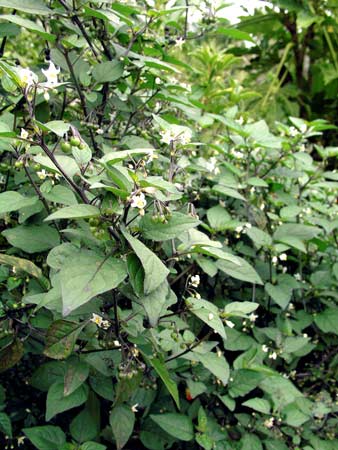

Origin, Distribution and Composition
The black nightshade, also known as sunberry or wonder cherry, is a small, erect and delicate annual herb. It forms a spreading crown, grows diffusedly with several arching branches up to one meter in height. The stems and branches are smooth and soft. The plant has alternate, egg-shaped, elliptic leaves; white, cream or violet flowers in clusters, purple or black fruit when ripe; with blue or black seeds.
The black nightshade is a native of West Africa, but is now grown all over India as well.
An analysis of black nightshade or manathakkali leaves shows them to consist of moisture 82.1 per cent, protein 5.9 per cent, fat 1.0 per cent, minerals 2.1 per cent and carbohydrates 8.9 per cent per 100 grams. The minerals and vitamins presents in it include calcium, phosphorus, iron, riboflavin, niacin and vitamin C. Its calorific value is 68.
The plant and the fruit contain toxic alkaloid solanine and saponin. Feeding experiments on sheep for toxicity, however, showed negative results.
Healing Power and Curative Properties
The black nightshade is used as an important ingredient in several Indian medicines. It is a valuable cardiac tonic. It corrects disordered processes of nutrition by which the organism ingests, digests, absorbs, transports, utilizes and excretes food substances, and restores the normal function of the system. It also reduces excitement, irritation and pain.
The leaves of the plant are mildly bitter, which becomes less pronounced after cooking. The fruits of the plant are of tonic value and serve as an effective laxative. They improve appetite.
The plant is beneficial in the treatment of dropsy. It increases the secretion and discharge of urine. Either it can be used as decoction or as a vegetable in the treatment of this disease. An extract of the leaves and stem, in doses of 6 to 8 ml., can also be taken.
Manathakkali leaves are useful in fevers. A syrup of the vegetable can be given as a cooling drink. To induce copious perspiration, a hot infusion of 0.75 to 1.25 decigrams, of dried leaves can be used. The fruits of the plant can also be given with beneficial results in fevers.
Stomach Disorders
The leaves are effective in the treatment of digestive disorders. The raw juice of the leaves can be used alone or mixed with other juices or liquids. It is used in stomach disorders like flatulence, peptic ulcers and colitis. An infusion of the plant is useful in dysentery and other stomach ailments.
Asthma
The plant helps in removing catarrhal matter and phlegm from the bronchial tubes in asthma patients. The fruits of the plant can also be used beneficially in treating asthma.
Skin Disorders
The plant is useful in chronic skin diseases. The juice extracted from the plant should be given in doses of 180 to 210 ml.
The juice can also be applied locally on the affected parts in chronic skin disease such as acne, eczema and psoriasis. As an anodyne or pain reliever, a decoction of the plant can be used for washing inflamed, irritated and painful parts of the body.
A paste of the plant serves as a useful applicant over corrosive ulcers, pustules and suppurating syphilitic ulcers, severe burns, herpes and rheumatic joints. Green fruits of the plant can be ground and applied locally on ringworms with gratifying results. A juice or poultice of leaves can be effectively applied on eruptive skin diseases, whitlow and burns.
Other Diseases
Hot leaves can be applied with gratifying results over swollen and painful scortum and testicles. A juice or poultice of the leaves is an efficacious application over rheumatic and gouty joints, corrosive ulcers and tumors. A decoction of the leaves can be used to wash tumors and inflamed, irritated and painful parts or the body.
Manathakkali leaves are popularly used as a vegetable. The leaves blend well with other greens and pulses. The juice of the leaves can be mixed with medium like coconut water, coconut milk, butter-milk, cow's milk and fruit juice.

Thanks for the info & particularly the good photos. I ate a berry thinking it was a black current then had my doubts. In seeing the photos above i instantly recognised the plant. Just to feed back: the taste was a little bitter but strange, as it didn't taste like anything i've had before. It certainly didn't taste like a sweet black current. the juice from the berry was green with little seeds in. i have to say, think back to it, i did have flatulence!! (while digging for my potatos before the moment) and dont have it now 1hr later???!!!.
ReplyDelete